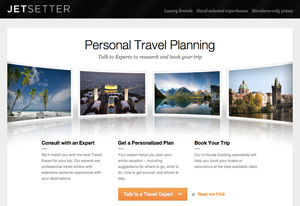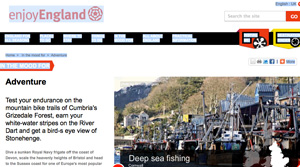
![]() By Nicole Petrak, ATTA Special Projects and Assistant Editor, AdventureTravelNews
By Nicole Petrak, ATTA Special Projects and Assistant Editor, AdventureTravelNews
In the constantly evolving world of online advertising, the clear shift towards content - to entertain, inform, and transform interest into action - has been hailed by Internet gurus such a Guy Kawasaki and Seth Godin as a new era. The travel industry is particularly lucky - opportunities for content generation and storytelling abound - but beyond posting video and pictures, and writing company blog posts - what does successful content generation look like today?
Quality content must inform, and consumers will spend more time looking at a brand that gives useful information about a general topic of interest - only once they have all the information needed to make a decision will they be open to choosing your brand as the solution. Therefore, the more detailed information you give to help them with that decision, the more likely they are to view your brand as reliable and trustworthy. Good content should also be available to consumers in a way that allows them to personalize their experience - be it by choosing what platform they’d like to consume it on, or actually allowing them to customize the types of content you offer them based on their needs at the moment. And to initiate sales, content should inspire rather than sell - think back to the focus on experience when discussing value - you’re selling the experience they hope to have, not your product. Below are some examples of new ways companies are using and creating content.
Travel flash sales... with a twist

Jetsetter, luxury brand Gilt’s flash sales site for travel, has launched Personal Travel Service, a feature that connects travelers with one of over 200 travel writers - called “correspondents” - who are matched to customers according to similar interests and tastes. According to Jetsetter’s press release:
Personal Travel Planning is unique because correspondents make their living traveling the world and contributing to outlets such as Conde Nast Traveler, Fodor's Guidebooks, Travel + Leisure and Vogue. Correspondents are based around the globe and are often providing insider tips on restaurants and sites located right outside their door.
Mashable notes (in a very worthwhile piece on 5 Fresh Digital Media Trends to Watch) that this “content and commerce blend” is part of a larger movement in the e-commerce industry where brands become more like traditional magazines and media publishers:
Platforms such as YouTube, WordPress and Twitter have made it easier and more affordable than ever for brands to create and distribute their own content, thereby becoming media companies in their own right. Brands are investing accordingly — whether they’re hiring editors, producers and social media managers, or expanding the roles of their existing teams — to create editorial, visual, audio and other kinds of content.
Describe it and they will come

VisitEngland recently announced a “set of new digital products aimed at modernising visitor information for the 21st century traveller,” including a new enjoyengland.com website offering over 600 unique concepts also developed by travel writers and funneled to users through various criteria they select online including season, location, interest area, and mood. In this way, the site is is both content-rich and built for personalization - and has been launched with a new iPhone app and a pilot scheme using QR codes so visitors can scan local fixtures for more in-depth videos and content once on the ground. James Berresford VisitEngland, Chief Executive said:
Our research showed us that while more people are keen to holiday at home, potential visitors felt there wasn’t enough information to inspire them at the start of the decision making process. Our new digital products address this problem with abundant ideas and inspiration. To remain competitive on the world stage we must ensure the quality of our visitor information online, via mobile technology, and in-destination is the best it can be. This is the start of a modernisation programme that will ensure visitors get the very best out of their trip in England.
Sell experiences, not things
Kerry Bodine, a Marketing & Strategy blogger for Forrester.com wrote a salient post about how marketers are increasingly advertising the customer experiences their companies deliver rather than the products themselves, a shift in values on behalf of both the companies and the consumers. She points to Virgin America’s subway ads in San Francisco that read “LAND WITH AN EMPTY INBOX. SFO → DALLAS FORT WORTH WIFI,” and Jet Blue’s series of humorous YouTube clips that emphasizes its competitors’ lesser polices when it comes to legroom, beverages, and baggage fees. Both ads are essentially selling how people will feel after flying with their brand instead of a competitor’s brand rather than listing or comparing amenities. For Bodine, the key lesson is that people on both the customer experience side and the marketing division need to craft external messages together:
Customers have begun to demand better and better interactions with companies — and they’re willing to vote with their wallets if they don’t get the kind of customer experiences they’re after. At the same time, top-level execs have finally started to realize that great customer experiences translate into metrics like brand equity, word-of-mouth awareness, incremental revenue, cost savings, and employee retention. These new values are increasingly being reflected in the outward communications from the marketing department.
Part of selling an experience is bringing the material to life for views. Amanda See, Regional Director of Sabre Limited Holdings, confirmed this in an interview about “Smart” websites with EyeForTravel:
Travellers today are often looking for very specific details of what they can expect from their experience. Video can be utilised to sell your brand experience in a fuller and richer way than most other media, … A visually rich site has been shown to have a high impact on visitors and can engage quickly and effectively. The more high quality video content you can provide, the more opportunity the website has in showcasing the total experience that users can expect from your brand.
Catch them early
It’s important to note in the cases mentioned above that the purpose of content is primarily to affect early stage travel decisions and planning - and research has reflected that this stage is influenced mainly - and equally - by online web research of content and input from social networks, both on and offline. Data from the 2011 Portrait of American TravelersTM shows that family and friends and travel guidebooks are currently slightly more important than Internet searches in the ideas and inspiration” stage: “thus, the most effective destination and travel service supplier marketing strategies must include both offline and online components.”
The growing impact of family and friends on purchase behaviors has resulted in melding consumer-related content with company advertising as a very popular and effective tool, and we’re starting to see more companies reward customers for using their products by tying loyalty rewards and programs to social media “check-in” and “shout out” habits. It is important to remember this content, while more valuable when positive, is riskier and more mercurial - even a positive review from a customer online can contain negative components. And, brands find more often these days that consumers adapt the brand image to their liking rather than accepting the messages fed to them by marketers - the most successful brands have run with this.
A word of warning
Dynamic content is important, but ease of use trumps all when keeping consumer attention online. A recent study released by Cybercom, a high-tech consultancy group, shows that how long a web page takes to load is critical in not losing a customer to a competitor, and is responsible for a full third of lost business online. Cybercom asserts this as especially true for travel sites, on which visitors begin to lose interest after only two seconds, and after three seconds, 40 percent of customers leave the site; over half of travel websites online today sites take so long to load that viewers move on. The lesson: make sure the tech is up to date to support your content, or it’s wasted.
Worried about creating content?
The emphasis around new and interesting content can easily overwhelm any non-professional blogger. The focus should remain on information that is important to your customer - instead of thinking you want them to know about your business, start with what they might want to know about travel to your destination or other topics generally interesting to them. Alternatively, content should be based around storytelling - delve into an anecdote about a unique experience had on a recent trip, a personal story revolving around a charitable initiative, lessons learned, or new and innovative things.
Get involved with your loyal customers and ask for their stories, candid photos and feedback - co-created content can help mitigate some of the risk in using consumer content. Be sure to inform the customers ahead of time about how your company intends to the use the information and/or images and ensure you have full permissions prior to publishing And, as Roxana Strohmenger notes in her Forrester.com.com blog, Latin Americans - in particular Brazilians and Mexicans - are “voracious” social media users who present an opportunity to brands willing to engage with them - not only are they exceptionally open to to connecting with brands on these platforms, but highly interested in consuming media created by companies and also have an “inherent willingness to co-create with companies.” Given the magnitude of travel opportunities brewing in this region, both inbound and out, companies should seize this willingness to gain or strengthen brand footholds here.
Finally, don’t overlook your business partners and suppliers when sourcing for regular and engaging content. Sarah Fazendin, Principal Consultant for Travel Marketing Worldwide, remarks:
Content marketing, particularly B2B content marketing, is extremely exciting for the adventure travel industry. A marketing outlet over which we have complete control, now international suppliers of travel can connect with and support business partners by creating content that can easily be shared across online and social networking platforms. By making it easy for business partners to repackage and share content when marketing direct to consumers, international suppliers of adventure travel have a great opportunity to solidify long term relationships leading to increased sales from the U.S. market.
Fazendin suggests selecting business partners that share your brand’s philosophy, making sure you're constantly producing images and video and sharing this material liberally, and utilizing content created on trips.
Assistant Editor's Note: Sarah Fazendin will be co-leading with Kathy Dragon an upcoming ATTA member’s only webinar,
Content is King; Making the most of your supplier/operator relationships to enhance marketing strategies for more detailed information on content creation.
What strategies have you had success with in online content, or seen other companies do well?
Feature image adapted from a photo by Josh Berglund.
